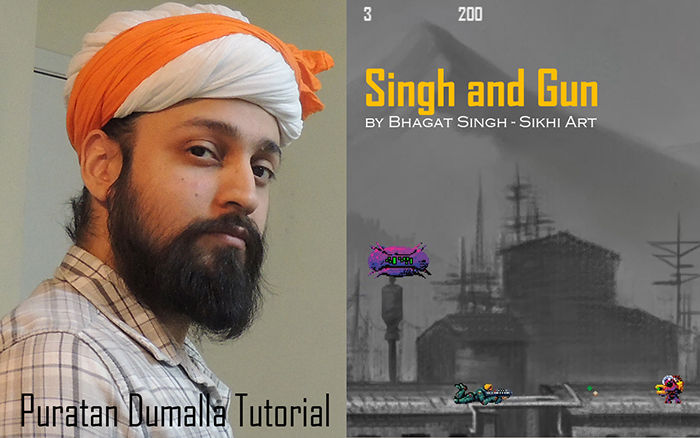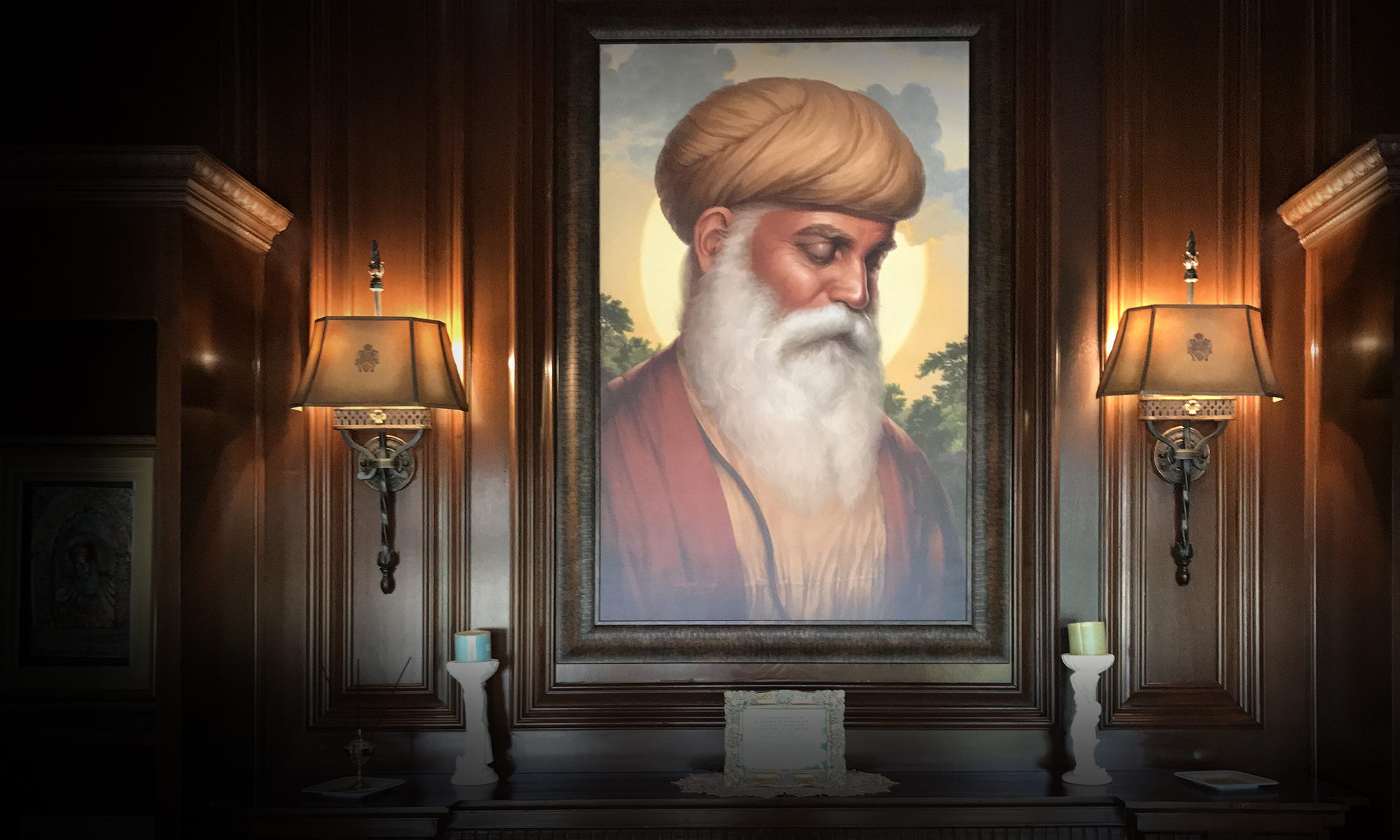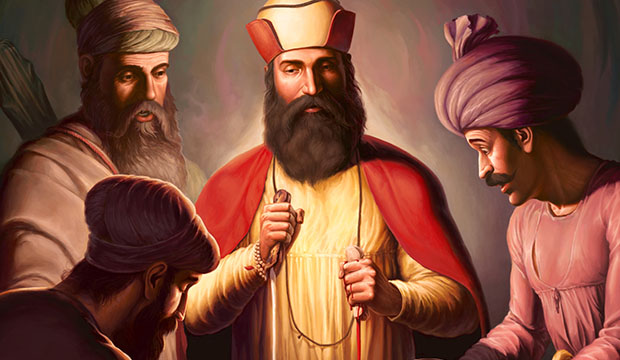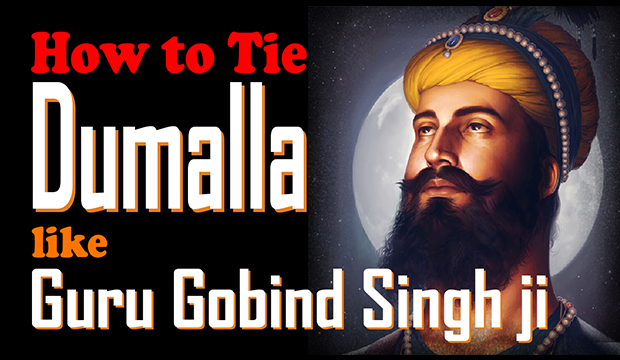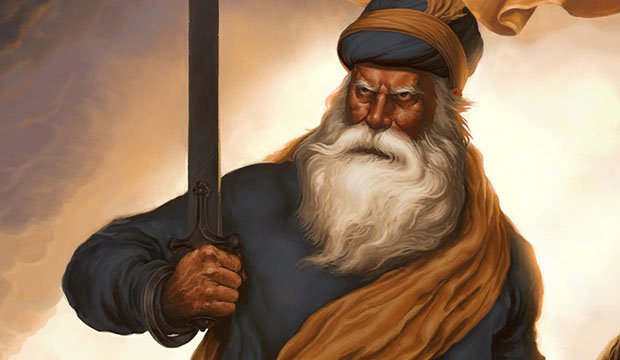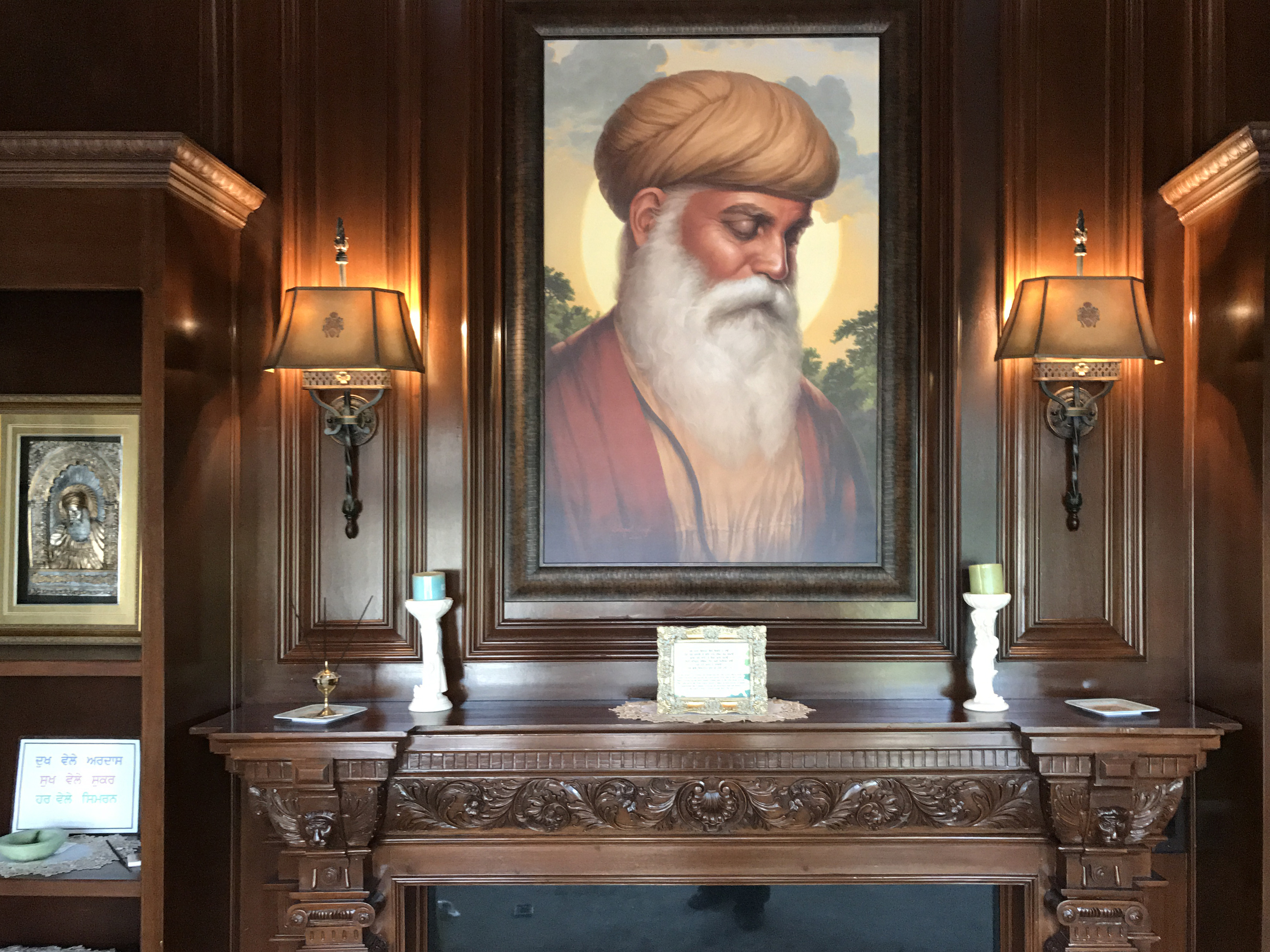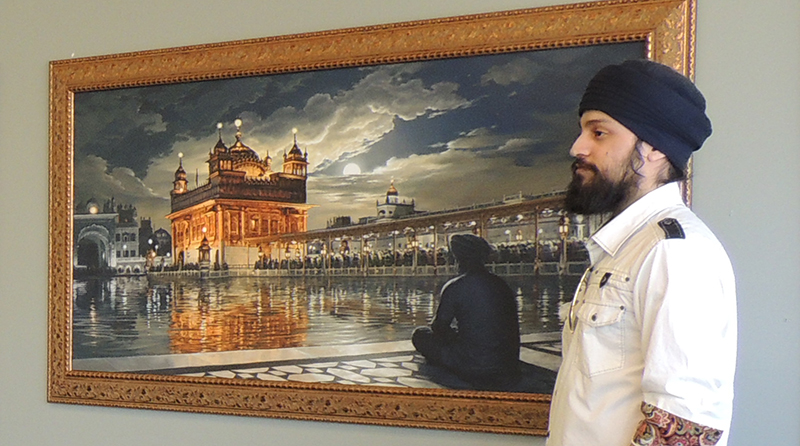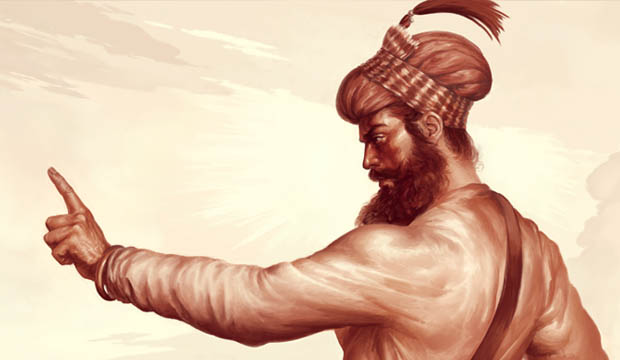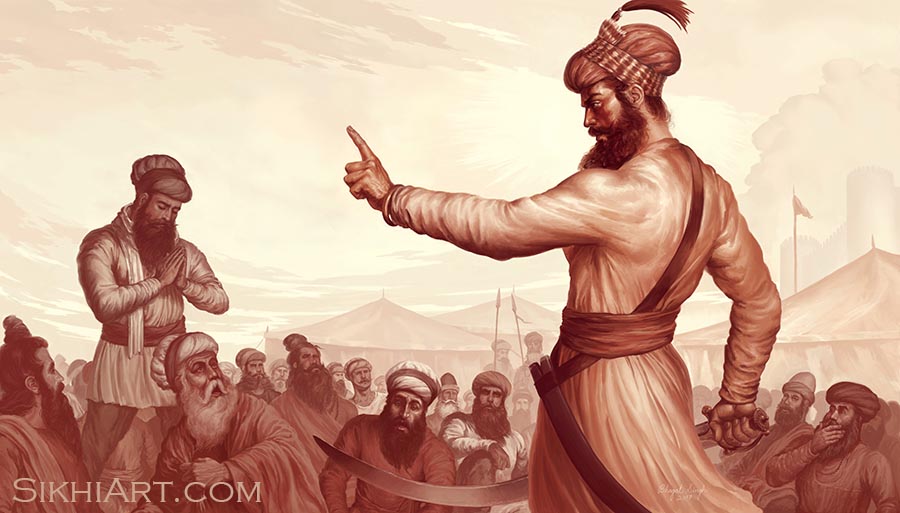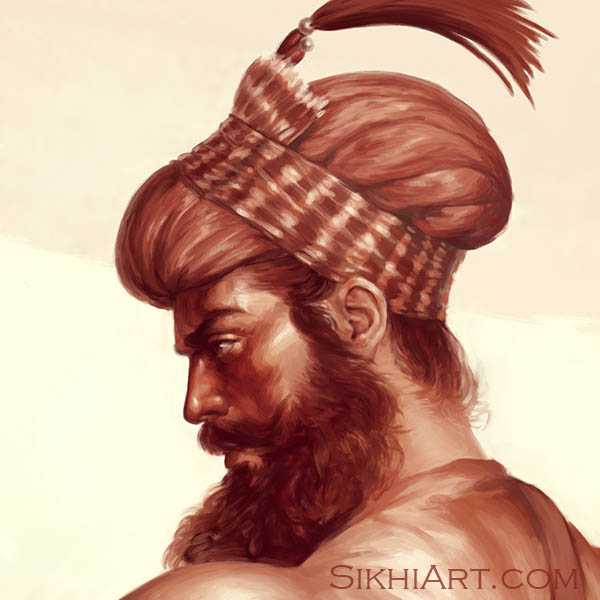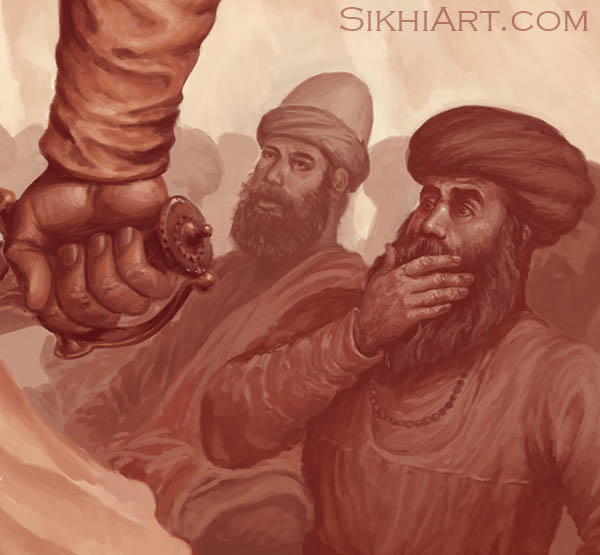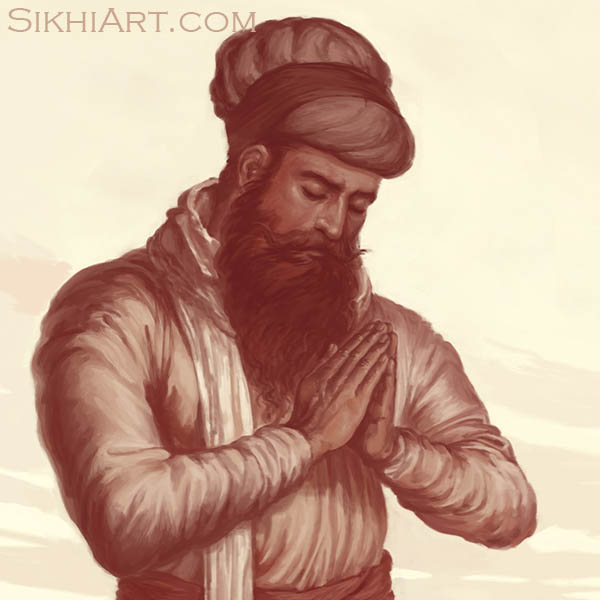“If blood gets on one’s clothes, we say the garment has become polluted. Those who suck the blood of human beings, how can their consciousness be pure? Guru Nanak Dev ji says [perform Responsible Actions and] Meditate on the Name of the Supreme Consciousness, with a pure heart. Everything else is just a pretentious display, and the practice of irresponsible actions.”
– Guru Nanak Dev ji (Guru Granth Sahib, 140)
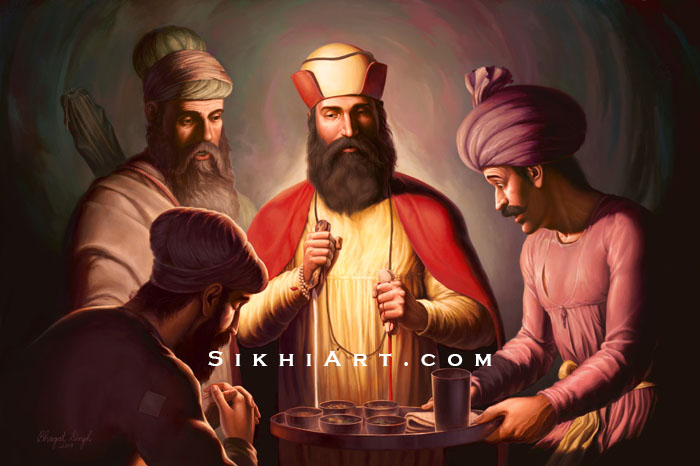
In my latest Sikh Painting, Guru Nanak Dev ji demonstrates that Bhai Lalo ji’s bread, earned through Responsible Actions and Meditation, is dripping with Milk. It nourishes everyone around Bhai Sahib, who bows to the Guru. Whereas the bread of Malik Bhago, earned through irresponsible actions, is dripping with Blood. It sucks the blood of those around Malik Bhago, who is looking shocked by the revelation. Standing behind Guru ji, Bhai Mardana ji watches the miracle in awe.
Painting Guru ji’s Four Symbols
Ever since I learned that Guru nanak dev ji wore Four Symbols – Topi, Seli, Tilak and Mala I always wanted to paint Him with these symbols.
Guru Granth Sahib ji and our Puratan Itihaasic scriptures all talk about Guru ji’s 4 symbols. Bhai Kahn Singh ji’s Mahan Kosh also mentions them.
These were Symbols worn by Saints of Medieval India, those who taught Bhagti.
1. Topi is an Old Style of Cap. In puratan art, we see Guru Nanak Dev ji depicted with 3 styles of Caps, which people wear in Himachal Pradesh, Tibet and Afghanistan, in the modern day.
2. Seli is a Black String. Sometimes worn on the cap, sometimes around neck (like a necklace or like a gatra), sometimes both. No current practice of wearing such a string exists in modern day. But it is spoken of and depicted in ancient literature and art.
3. Tilak is a Forehead Mark. It can be seen amongst Sadhus in modern day.
4. Mala is a Rosary. It’s well known today as a Tool for practicing meditation.
Hidden Away in History
This knowledge is nowhere to be found within our community. No one knows about it or talks about it. Even I didn’t know and when I found out, I was taken aback and it caused me to reflect on our situation. I recognized the need within the community of more knowledge and more historically authentic paintings.
Seeing this need I thought I should do a painting where Guru ji is wearing His 4 symbols. However I thought people do not see Him as such and would not want to own such a painting.
To be honest, at that time I did not see Guru ji with His 4 symbols either however I knew that the current style of turban we see him in, is a modern invention.
Meditating on Guru ji
So I started drawing Guru Nanak Dev ji everyday with seli and topi (I would later add the tilak and mala as well). At first it seemed odd. The drawing looked like Guru Nanak Dev ji and looked familiar however it also looked strange at the same time.
Nonetheless I was fascinated by Guru ji’s appearance.
I drew him more and more. Many of these sketches I later shared on my social media.
As I drew Him my mind was absorbed in His feet. In moments of complete absorption, I knew what I was drawing was the Guru and that He was guiding me to draw Him. So despite having reluctance and reservations, I carried on doing this process.
Days and nights I meditated as I drew Guru Nanak Dev ji. If I went out, I would park my vehicle and draw him for 40-50 minutes or so.
In those moments I felt like –
ਜਿਥੈ ਜਾਇ ਬਹੈ ਮੇਰਾ ਸਤਿਗੁਰੂ ਸੋ ਥਾਨੁ ਸੁਹਾਵਾ ਰਾਮ ਰਾਜੇ ॥
Raja Ram ji, wherever my Guru goes, that place is the most beautiful to me. (Ang 450)
I was in bliss.
This went on for a year or more, I can’t remember. Every time I would go somewhere I would take my sketchbook and draw Guru Nanak Dev ji in seli, topi, tilak and mala, while meditating.
It got to the point where sometimes my eyes would tear up as I enjoyed the emotions of the meditation.
Sikh Art for Gurpurab 550 Years
A few months ago I heard the community was celebrating Guru Nanak Dev ji’s 550th Gurpurab and I thought what better way to showcase the 4 symbols of Guru Nanak than to paint something for the 550th Gurpurab.
Several years ago I had started a painting of Guru Nanak Dev ji with seli topi holding the roti of Bhai Lalo ji and the roti of Malik Bhago, and showing the difference between one who performs Responsible Actions and Meditation, which nourishes the calves around them, and one who performs irresponsible actions which sucks the blood of the beings around them.
Originally I had Guru ji wearing wearing seli topi however part way through the process I changed it into a turban. Although I made progress on it, I started to lose interest and I stopped working on the painting.
I had tampered with my original vision, which came from Guru sahib and changed it to a turban to appease the insecure part of myself. In hindsight, that was not a good idea. (This was many years ago.)
After the past few years, after my experiences of drawing Guru sahib, I went back and changed the painting back to seli topi and it rejuvenated the painting.
The inspiration that came from that allowed me to do significant amount of work on the painting in a short amount of time.
Lessons Learned
The lessons I learned, I still try to ingrain them deeper into my being because the mind wanders from Guru ji’s teaching.
Guru ji said to not worry about other people, to let go of insecurities and to simply focus on Him. I would lose sight of this and He would again come and tell me to focus on what He said.
During the month of October with Diwali coming up ahead, I started to translate Guru ji’s bani on a daily basis and each day I would contemplate His teachings and focus my mind on Ram naam.
Doubt and fear are activities of the mind. They are like waves in the ocean. They come and go. This was the insight that came. I felt it deeply within.
Over my journey as an artist, Guru ji has taught me to dive into the ocean and taught me to swim as a free spirit alongside His other fish.
Some people say to keep spiritual experiences private, hidden from the public. While I keep almost all of them to myself, sometimes it becomes necessary to share a few with you guys so that you can understand the evolution in my art, and where it is coming from.
Of course there are people who will never understand this state of being nor the evolution that follows it. But for most people, it may be necessary from time to time, to explain the art, to add context to the image, so that they can enjoy it better.
About the Painting
This is a Puratan Style painting of Guru Nanak Dev ji, where Guru ji is dressed as he is shown in Puratan Sikh Art.
The style of painting is Puratan as well, but from Italy. I am a big fan of the Master Artist, Caravaggio, a 16th century artist, from the renaissance period of Italy. I have learned many things from him, despite never meeting him.
You can see his direct influence on my painting of Guru Arjun Dev ji’s martyrdom.
There is a famous painting of Guru Nanak Dev ji by Ustaad Sobha Singh ji, where Guru ji is shown blessing the viewer. Whereas Sobha Singh ji set a modern look for Guru sahib. I wanted to take the viewer back to Guru ji’s Puratan look, perhaps His original historical look, and show that off to newer generations.
So I painted the puratan look of Guru Nanak Dev ji that we see in Janamsakhis of 1700s, but with the puratan style of Ustaad Caravaggio ji from 1500s.
With that I hope I have given you guys a glimpse into our history with this piece.
The intention is not to offend anyone’s faith or belief system but simply to express our Itihaasic relics and artifacts that show us our past, and move forward under the guidance of Guru ji.
Bhagat, do you think Sikhs should wear a Seli and Topi?
The tradition of Seli and Topi was changed by the sixth Guru to that of Gatra and Dumalla (see Gurbilas Patshahi 6).
My intention here is only to show Guru Nanak Dev ji’s historical form and appearance, not to suggest to anyone to wear it.
My message to the community is to follow Guru ji’s teachings to us, in His sixth form, and continue to wear a Turban and a Sword belt as per His instructions.
If you don’t wear a Turban, my message to you is – start to think about where you belong, and who you worship. If you worship the Gurus then understand the depth of their message and the importance of the traditions they started.
When we go to the Gurudwara and benefit from a free meal, we should first think – “Am I performing responsible actions and meditation?” and then think – “Am I giving back to the Guru’s tradition by wearing the physical appearance that He blessed me with?”
If we benefit from one sikh tradition, langar tradition, but do not give back into the community by following other sikh tradition of maintaining uncut hair and turban, then we must take a serious look at our life.
In my view we should all wear turbans over our long hair, as that is Guru ji’s order. But it is also important to share Guru Nanak Dev ji’s original appearance, as it revealed itself to me in puratan literature and puratan artwork, and then in my Being.
Fine Art Prints for Sale
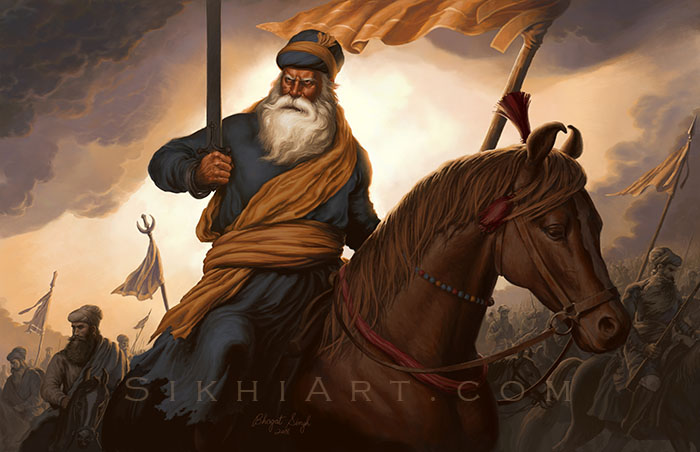
Support Projects, Get Rewards
